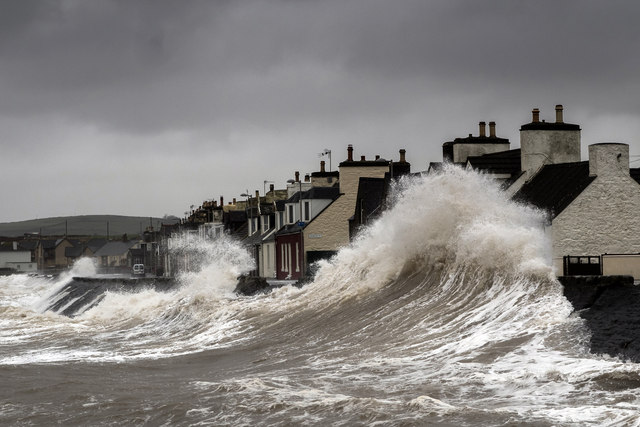 Last week, even as North and South Carolina were evacuating people in preparation for Hurricane Florence, a sinister Category 5 Typhoon Mangkhut was barreling its way towards East Asia.
Last week, even as North and South Carolina were evacuating people in preparation for Hurricane Florence, a sinister Category 5 Typhoon Mangkhut was barreling its way towards East Asia.
Mangkhut has become one of the most powerful storms of 2018 causing devastation and landslides in the northern Philippines and killing 81 people with its Category 5 winds. It then crossed the South China Sea and hit Hong Kong and the Guangdong Province of China with winds of 100 mph. More than 2.45 million people have been evacuated from their homes and relocated to a safe shelter. Additionally, water levels have risen to almost 3.5 m (12 ft), which even led to fish washing up on to the streets.
Meanwhile, Florence was downgraded to a Category 1 storm as it made landfall. However, it has caused flooding and devastation in the Carolinas and killed 32 people. More than 15,000 people are living in emergency shelters scattered across the two states, and thousands are without electricity. Florence is gradually drifting west and whipping up winds of 35 miles per hour. It is expected to move up the East Coast, hitting Maine and New Jersey before it leaves the U.S by the end of this week.
We had written last week about how tropical storms form. This week, we look at what words such as categories, landfall, storm surges, floodplains and waffle index mean.
Storm Categories
 The categories of a storm are measured on the Saffir-Simpson Wind scale, which goes from one to five. This scale was invented in the 1970s by engineer Herbert Saffir and Robert Simpson in Miami.
The categories of a storm are measured on the Saffir-Simpson Wind scale, which goes from one to five. This scale was invented in the 1970s by engineer Herbert Saffir and Robert Simpson in Miami.
This scale doesn’t predict every little detail about a storm but gives a sense of how much destruction it is likely to cause. In a category one storm, winds go from 74 to 94 mph and will cause some damage. The highest category on the scale, a Category five, has a minimum wind speed of 157 mph. A storm of this magnitude will cause catastrophic damage to property and lives, and disrupt electricity and water supplies. Learn more about storm categories here.
Landfall
A tropical storm consists of a center (called the eye of the storm) where winds are the calmest. It appears as a hole in the middle of swirling clouds in pictures. The eyewall refers to cumulonimbus clouds that swirl around the eye and are considered the most dangerous part of the hurricane, capable of producing 150 mph winds and heavy rainfall. The eyewall is surrounded by rainbands that bring intense showers and thunderstorms.
A storm is said to have made landfall when its eye crosses the shoreline. We know that the strongest part of a storm isn’t the direct center. The strongest winds of a storm can still occur even if landfall hasn’t occurred yet. Conversely, it’s possible for landfall to occur, but the strongest winds may still be on the water.
Floodplains and Storm Surges
 Winds from a tropical storm cause water in the ocean to circulate vertically. When the storm hits the coast where ocean floors are not deep, the water is forced up on to the land -- and this is referred to as a storm surge.
Winds from a tropical storm cause water in the ocean to circulate vertically. When the storm hits the coast where ocean floors are not deep, the water is forced up on to the land -- and this is referred to as a storm surge.
On the other hand, floodplains are the low lying areas of lands that are prone to flooding. Meteorologists create floodplain maps so they can plan evacuations ahead of time. A 50-year-old floodplain rating means that the area has about a one-in-50 chance of flooding. These maps also play a huge role in how much a homeowner pays for insurance or where a company can build.
Waffle House Index
Waffle House Index is a term used by the Federal Emergency Management Agency(FEMA) to show which areas have been hit hardest by a disaster. The term Waffle House Index is named after the Waffle House chain of restaurants that are open 24-hours. According to Craig Fugate “If a Waffle House is closed because there’s a disaster, it’s bad. We call it red. If they’re open but have a limited menu, that’s yellow,” he explained to NPR, America’s public radio network. Fully functioning restaurants mean that the Waffle House Index is shining green.
Waffle House has developed a crisis management process and a manual on how to open after a disaster. Waffle House even has a “Storm Center” which assesses a storm's path and its impact on their restaurants!
Finally, Those Storm Names...
Each year, meteorologists create a list of approved names right before storm season. Storms are named alphabetically, for example, the first storm of the season would be named Abby, and then Bruce, and so on. When the practice of naming storms began in 1950, only make names were used. But by 1979, both male and female names are chosen. Tropical storms are given names when wind speeds reach 39 mph (63 kph) and if a storm causes extreme devastation, its name is retired and never used again.
Now that you know what these terms mean, you can understand better when people around you use them!
Sources: NY Times, CNN, Time, Earth Sky, The Weather Channel, Economist, Reuters








